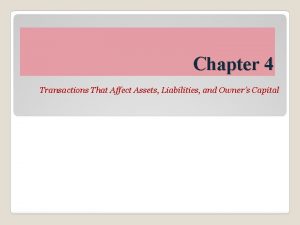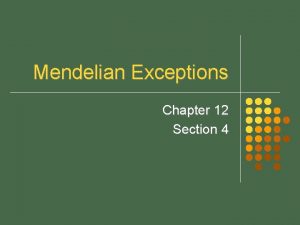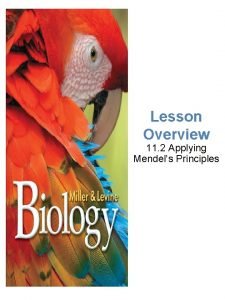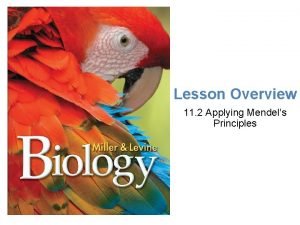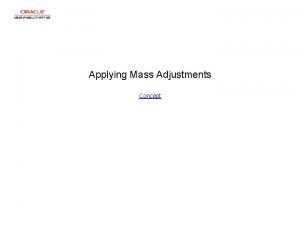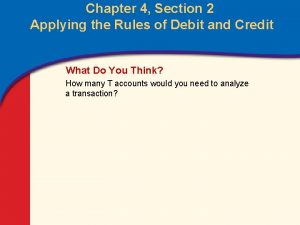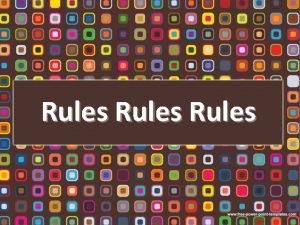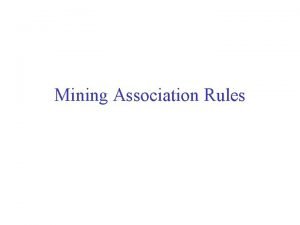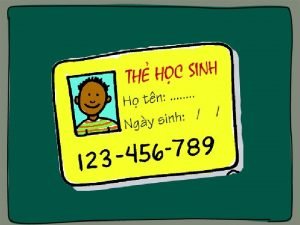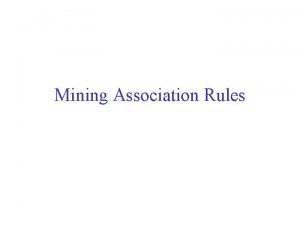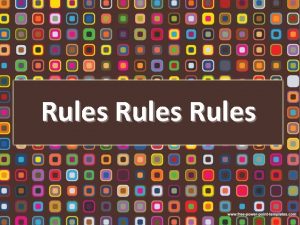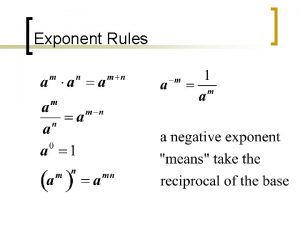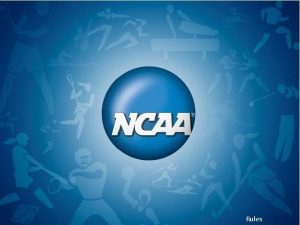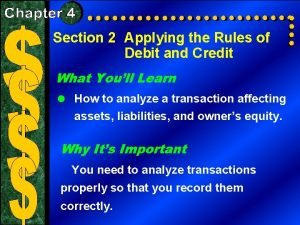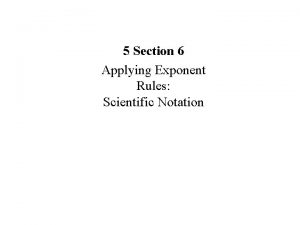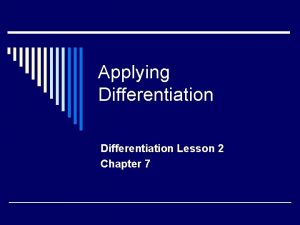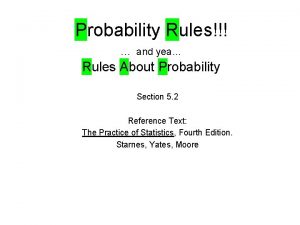Chapter 4 Section 2 Applying the Rules of





















- Slides: 21

Chapter 4 Section 2 Applying the Rules of Debit and Credit

Transactions That Affect Assets, Liabilities, and Owner’s Capital Objectives: • Prepare a chart of accounts • Explain the purpose of double-entry accounting • Identify the normal balance of accounts • Use T-Accounts to illustrate the rules of debit and credit for asset accounts, liability accounts, and the owner’s capital account and to express the accounting equation.

Objectives: cont… • Calculate the account balances after recording business transactions. • Define the accounting terms introduced in this chapter.

Why it’s important? Transactions That Affect Assets, Liabilities, and Owner’s Capital: ü You need to analyze transactions into debit and credit parts.

PANDA RESTAURANT GROUP Andrew and Peggy Cherng opened their first Panda Inn in Pasadena, California. Use recipes from Andrew’s father, Master Chef Ming-Tsai Cherng. Now has more than 700 stores in 36 states, Puerto Rico, and Japan. Their mission is to reach a goal of 10, 000 Panda Express restaurants.

Section 4 -2 Applying the Rules of Debit and Credit Main Idea: use the T-Accounts to analyze transaction. ü Step-by-step method for analyzing transactions. ü How to apply the method to asset, liability, and owner’s capital transactions.

Instant Recall. . . Property and Financial Claims Assets = Property Equities = Creditors’ Claims + Owner’s Claim

Section 4 -2 Assets and Owner’s Capital Transaction #1 On October 1 Maria Sanchez took $25, 000 from personal savings and deposited that amount to open a business checking account in the name of Roadrunner Delivery Service. Step 1: Identifying the accounts Step 2: + or Cash in Bank Debit Credit Maria Sanchez, Capital Debit + Credit + Step 3: Debit – Credit Rule and T-Accounts Cash in Bank Debit 25, 000 Credit Maria Sanchez, Capital Debit Credit 25, 000

Section 4 -2 Assets and Owner’s Capital Transaction #2 On October 2 Maria Sanchez took two telephones valued at $200 each from her home and transferred them to the business office equipment. Step 1: Identifying the accounts Step 2: + or Office Equipment Debit Credit Maria Sanchez, Capital Debit + Credit + Step 3: Debit – Credit Rule and T-Accounts Office Equipment Debit 400 Credit Maria Sanchez, Capital Debit Credit 400

Section 4 -2 Assets and Owner’s Capital Transaction #3 On October 4 Roadrunner issued Check 101 for $3, 000 to buy a computer system. Step 1: Identifying the accounts Step 2: + or - Computer Equipment Debit Credit Cash in the Bank Debit Credit - + Step 3: Debit – Credit Rule and T-Accounts Computer Equipment Debit 3, 000 Credit Cash in the Bank Debit Credit 3, 000

Section 4 -2 Assets and Owner’s Capital Transaction #4 On October 9 Roadrunner bought a used truck on account from North Shore Auto for $12, 000. Step 1: Identifying the accounts Step 2: + or Delivery Equipment Debit Credit + Accounts Payable--North Shore Auto Debit Credit + Step 3: Debit – Credit Rule and T-Accounts Delivery Equipment Debit 12, 000 Credit Accounts Payable--North Shore Auto Debit Credit 12, 000

Section 4 -2 Assets and Owner’s Capital Transaction #5 On October 11 Roadrunner sold one phone on account to Green company for $200. Step 1: Identifying the accounts Step 2: + or Accounts Receivable--Green Company Debit Credit Office Equipment Debit Credit - + Step 3: Debit – Credit Rule and T-Accounts Receivable--Green Company Debit Credit 200 Office Equipment Debit Credit 200

Section 4 -2 Assets and Owner’s Capital Transaction #6 On October 12 Roadrunner mailed Check 102 for $350 as the first installment payment on the truck purchased from North Shore Auto on October 9. Step 1: Identifying the accounts Step 2: + or Accounts Payable--North Shore Auto Debit Cash in Bank Debit Credit - - Step 3: Debit – Credit Rule and T-Accounts Payable--North Shore Auto Debit Credit 350 Cash in Bank Debit Credit 350

Section 4 -2 Assets and Owner’s Capital Transaction #7 On October 14 Roadrunner received and deposited a check for $200 from Green company. The check is full payment for the telephone sold on account to Green Company on October 11. Step 1: Identifying the accounts Step 2: + or Cash in Bank Debit Credit Accounts Receivable--Green Company Debit + Credit - Step 3: Debit – Credit Rule and T-Accounts Cash in Bank Debit +200 Credit Accounts Receivable--Green Company Debit Credit -200

Check Your Understanding 1. What is a chart of accounts? 2. Why are the accounts numbered? 3. What is meant by the normal balance? 4. What is the normal balance for ASSET accounts? For LIABILITY accounts? For the OWNER’S CAPITAL account? 5. What are three basic parts of a T-Account.

Check Your Understanding 6. What are the 3 steps used to analyze a business transaction? 7. How do you determine the balance of an account? 8. What is the balance for the following accounts? Cash in Bank Debit Beg bal. 3, 000 1, 500 End bal 2, 000 Credit Accounts Receivable--Ambros Company 400 2, 100 Debit Beg bal. 3, 500 1, 800 End bal 1, 100 Credit 2, 100

BUSINESS TRANSACTION ANALYSIS: Steps to success 1. Identify the accounts affected 2. Determine the amount of increase or decrease. (+ or -) 3. Record the amount to be Debited and the amount to be Credited

Problem 4 -2 June 3, Transaction #1 t n u o c c a n o r e t u p m o c Purchased a , 500 2 $ r fo. c In r e t u p m o C from 1 2 3 Office Equipment + Debit Accounts Payable + Credit

June 9, Transaction #2 Transferred a desk to the business. The desk is worth $750 1 Office Furniture Alice Roberts, Capital 2 + + 3 Debit Credit

June 15, Transaction #3 Made a partial payment on account of $1, 000 to Computer Inc. 1 Cash Accounts Payable 2 - - 3 Credit Debit

Problem 4 -4 Cash in Bank 1) 40, 000 Bal 4) 7, 500 3, 750 Accounts Receivable —Valley Auto 5) 1, 200 Bal 1, 200 Office Equipment 4) 7, 500 Bal 7, 500 Accounts Payable--- Office Furniture Allen Vacuum Systems 3) 3, 750 Bal 2) 27, 000 3, 750 Bal 27, 000 Car Wash Equipment 2) 27, 000 Bal 25, 800 5) 1, 200 Regina Delgado, Capital 1) 40, 000 3) 3, 750 Bal 36, 250
 Chapter 4 review transactions that affect assets
Chapter 4 review transactions that affect assets Chapter 12 lesson 2 applying mendels principles
Chapter 12 lesson 2 applying mendels principles Chapter 12 lesson 2 applying mendel's principles
Chapter 12 lesson 2 applying mendel's principles Chapter 12 lesson 2 applying mendel's principles
Chapter 12 lesson 2 applying mendel's principles Chapter 33 applying paints and enamels
Chapter 33 applying paints and enamels Chapter 12 lesson 2 applying mendels principles
Chapter 12 lesson 2 applying mendels principles 17:10 providing first aid for specific injuries
17:10 providing first aid for specific injuries Cognitive learning theorist
Cognitive learning theorist Chapter 10 section 1 meiosis worksheet answer key
Chapter 10 section 1 meiosis worksheet answer key Hát kết hợp bộ gõ cơ thể
Hát kết hợp bộ gõ cơ thể Lp html
Lp html Bổ thể
Bổ thể Tỉ lệ cơ thể trẻ em
Tỉ lệ cơ thể trẻ em Voi kéo gỗ như thế nào
Voi kéo gỗ như thế nào Chụp tư thế worms-breton
Chụp tư thế worms-breton Chúa yêu trần thế
Chúa yêu trần thế Môn thể thao bắt đầu bằng chữ f
Môn thể thao bắt đầu bằng chữ f Thế nào là hệ số cao nhất
Thế nào là hệ số cao nhất Các châu lục và đại dương trên thế giới
Các châu lục và đại dương trên thế giới Công thức tính độ biến thiên đông lượng
Công thức tính độ biến thiên đông lượng Trời xanh đây là của chúng ta thể thơ
Trời xanh đây là của chúng ta thể thơ Cách giải mật thư tọa độ
Cách giải mật thư tọa độ
